
Messier 100 is a grand design intermediate spiral galaxy in the southern part of the mildly northern Coma Berenices. It is one of the brightest and largest galaxies in the Virgo Cluster and is approximately 55 million light-years from our galaxy, its diameter being 107,000 light years, and being about 60% as large. It was discovered by Pierre Méchain in 1781 and 29 days later seen again and entered by Charles Messier in his catalogue "of nebulae and star clusters".. It was one of the first spiral galaxies to be discovered, and was listed as one of fourteen spiral nebulae by Lord William Parsons of Rosse in 1850. NGC 4323 and NGC 4328 are satellite galaxies of M100; the former is connected with it by a bridge of luminous matter.

NGC 1365, also known as the Great Barred Spiral Galaxy, is a double-barred spiral galaxy about 56 million light-years away in the constellation Fornax.

NGC 3370 (also known as UGC 5887 or Silverado Galaxy) is a spiral galaxy about 98 million light-years away in the constellation Leo. It is comparable to our Milky Way both in diameter (100,000 light years) and mass (1011 solar masses). NGC 3370 exhibits an intricate spiral arm structure surrounding a poorly defined nucleus. It is a member of the NGC 3370 Group of galaxies, which is a member of the Leo II Groups, a series of galaxies and galaxy clusters strung out from the right edge of the Virgo Supercluster.
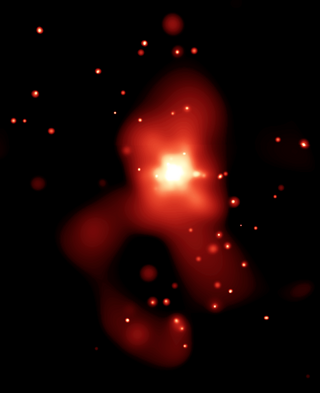
NGC 4261 is an elliptical galaxy located around 100 million light-years away in the constellation Virgo. It was discovered April 13, 1784 by the German-born astronomer William Herschel. The galaxy is a member of its own somewhat meager galaxy group known as the NGC 4261 group, which is part of the Virgo Cluster.

NGC 4639 is a barred spiral galaxy located in the equatorial constellation of Virgo. It was discovered by German-born astronomer William Herschel on April 12, 1784. John L. E. Dreyer described it as "pretty bright, small, extended, mottled but not resolved, 12th magnitude star 1 arcmin to southeast". This is a relatively nearby galaxy, lying approximately 72 million light-years away from the Milky Way. It is a companion to NGC 4654, and the two appear to have interacted roughly 500 million years ago. NGC 4639 is a member of the Virgo Cluster.
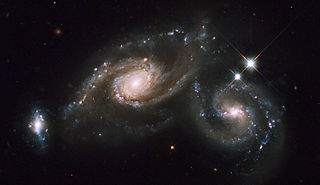
The NGC 5679 group, also known as Arp 274, is a triplet of galaxies, MCG+1-37-36, MCG+1-37-35 and MCG+1-37-34, spanning about 200000 light-years and at some 400 million light-years from Earth in the constellation Virgo. Arp 274 refers to the Atlas of Peculiar Galaxies, compiled by Halton Arp in 1966. Galaxies 269 through 274 in his catalogue are galaxies that appear to have connected arms.
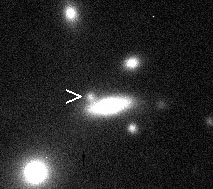
NGC 5177 is a lenticular galaxy. Based on a redshift of 6467 km/s the galaxy is crudely estimated to be about 300 million light-years away.

NGC 5584 is a barred spiral galaxy in the constellation Virgo. It was discovered July 27, 1881 by American astronomer E. E. Barnard. Distance determination using Cepheid variable measurements gives an estimate of 75 million light years, whereas the tip of the red-giant branch approach yields a distance of 73.4 million light years. It is receding with a heliocentric radial velocity of 1,637 km/s. It is a member of the Virgo III Groups, a series of galaxies and galaxy clusters strung out to the east of the Virgo Supercluster of galaxies.
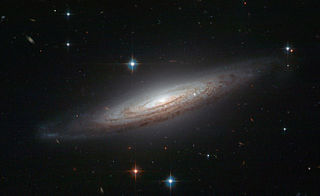
NGC 634 is a spiral galaxy, lying at a distance of 217.1 megalight-years away from the Milky Way in the northern constellation of Triangulum. This object was discovered in the nineteenth century by French astronomer Édouard Stephan. It is inclined by an angle of 82.4° to the line of sight from the Earth, and thus is being viewed nearly edge on.

IC 755, also known as NGC 4019, is a barred spiral galaxy. It lies about 60 million light-years away in the northern constellation of Coma Berenices. It is a member of the Virgo Cluster.

NGC 4183 is a spiral galaxy with a faint core and an open spiral structure located about 55 million light-years from the Sun. Spanning about eighty thousand light-years, it appears in the constellation of Canes Venatici. NGC 4183 was observed for the first time by British astronomer William Herschel on 14 January 1788.

NGC 4517 is a spiral galaxy located approximately 40 million light-years away in the constellation of Virgo. It was discovered in 1784 by William Herschel. It is a member of the Virgo II Groups, a series of galaxies and galaxy clusters strung out from the southern edge of the Virgo Supercluster.

NGC 1433 is a barred spiral galaxy with a double ring structure located in the constellation of Horologium. It is at a distance of 46 million light-years from Earth. It is a Seyfert galaxy with an active galactic nucleus. The central region of the galaxy displays intense star formation activity, with an irregular star-forming ring of 5″ radius and weak radio wave emission. Star formation is also noticeable in the spiral arms but not the bar of the galaxy. NGC 1433 is being studied as part of a survey of 50 nearby galaxies known as the Legacy ExtraGalactic UV Survey (LEGUS). A jet of material flowing away from the central black hole of the galaxy extending for only 150 light-years has been found. It is the smallest molecular outflow ever observed in a galaxy beyond our own.
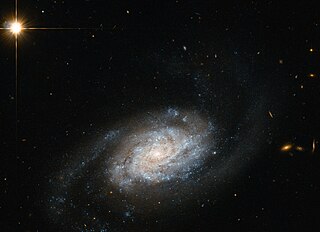
NGC 3455 is an intermediate spiral galaxy located 65 million light-years away in the constellation of Leo. It is a member of the NGC 3370 Group of galaxies, which is a member of the Leo II Groups, a series of galaxies and galaxy clusters strung out from the right edge of the Virgo Supercluster.

NGC 660 is a peculiar and unique polar-ring galaxy located approximately 45 million light-years from Earth in the Pisces constellation. It is the only such galaxy having, as its host, a "late-type lenticular galaxy". It was probably formed when two galaxies collided a billion years ago. However, it may have first started as a disk galaxy that captured matter from a passing galaxy. This material could have, over time, become "strung out" to form a rotating ring.
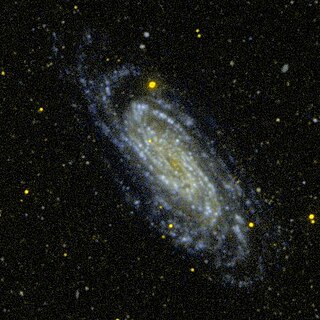
NGC 3198, also known as Herschel 146 is a barred spiral galaxy in the constellation Ursa Major. It was discovered by William Parsons, 3rd Earl of Rosse, sometime before 1850. NGC 3198 is located in the Leo Spur, which is part of the Virgo Supercluster, and is approximately 47 million light years away.

NGC 6052 is a pair of galaxies in the constellation of Hercules. It was discovered on 11 June 1784 by William Herschel. It was described as "faint, pretty large, irregularly round" by John Louis Emil Dreyer, the compiler of the New General Catalogue.

NGC 5308 is an edge-on lenticular galaxy in the constellation of Ursa Major. It was discovered on 19 March 1790 by William Herschel. It was described by John Louis Emil Dreyer as "bright, pretty large" when he compiled the New General Catalogue. A small, irregular galaxy near NGC 5308 has been given the designation LEDA 2802348.

NGC 4242 is a spiral galaxy in the northern constellation of Canes Venatici. The galaxy is about 18 million light years away. It was discovered on 10 April 1788 by William Herschel, and it was described as "very faint, considerably large, irregular, round, very gradually brighter in the middle, resolvable" by John Louis Emil Dreyer, the compiler of the New General Catalogue.

NGC 2525 is a barred spiral galaxy located in the constellation Puppis. It is located at a distance of about 70 million light years from Earth, which, given its apparent dimensions, means that NGC 2525 is about 60,000 light years across. It was discovered by William Herschel on February 23, 1791.





















